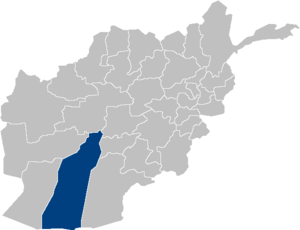Helmand Province, Afghanistan: Difference between revisions
Jump to navigation
Jump to search

imported>Howard C. Berkowitz (New page: '''Helmand Province''', in southern Afghanistan, has the largest area but relatively small population. Its capital is Lashkar Gah. ==Government and security== *Governor: Tooryalai...) |
mNo edit summary |
||
| (19 intermediate revisions by 4 users not shown) | |||
| Line 1: | Line 1: | ||
'''Helmand Province''', in southern | {{subpages}} | ||
{{Image|Afghanistan Helmand Province location.PNG|right|300|Location of Helmand Province within Afghanistan.}} | |||
'''Helmand Province''' is an arid, mountainous region in southern Afghanistan. It is geographically the largest province of the country but has a relatively small population. Its capital is [[Lashkar Gah]]. It shares its southern border with Pakistan's [[Balochistan Province]]. Over two-thirds of Helmand Province is mountainous, but it is noted for its agriculture and the growth of prime [[poppy (opium)|opium poppy]]. | |||
==References== | ==References== | ||
{{reflist}} | {{reflist}} | ||
[[Category:Reviewed Passed]][[Category:Suggestion Bot Tag]] | |||
Latest revision as of 16:01, 26 August 2024
Helmand Province is an arid, mountainous region in southern Afghanistan. It is geographically the largest province of the country but has a relatively small population. Its capital is Lashkar Gah. It shares its southern border with Pakistan's Balochistan Province. Over two-thirds of Helmand Province is mountainous, but it is noted for its agriculture and the growth of prime opium poppy.
